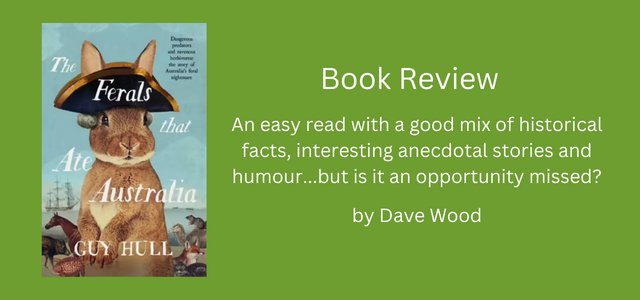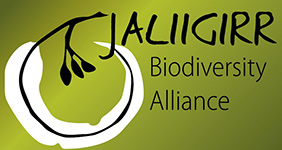
Book Review
Title: “The Ferals that Ate Australia”
Author: Guy Hull
The Ferals that Ate Australia is an easy read with a good mix of historical facts, interesting anecdotal stories and humour. It could be mandatory reading for anyone interested in invasive species or responsible for a non-native animal.
I am probably not alone in thinking that the introduction of many of our invasive species was simply the result of carelessness or accidental stowaway. Apart from Rattus rattus and the humble mouse, I could not have been more wrong.
To learn that in the late 1800s we had Acclimatisation Societies, primarily in Victoria and to a lesser extent in NSW, whose sole purpose was to introduce as many foreign species as they could was a concerning revelation. Even more disturbing was the list of species they introduced and those which fortunately failed to survive. This list includes many species of birds, fauna and fish. It also includes, monkeys, elephants and believe it or not … boa constrictors! The ones that did survive are the subject of Hull’s book, with the introduced rabbit starring front and centre.
Attempts to control and eradicate the humble bunny read a bit like the old tale of the Woman who swallowed the fly. The list of attempted solutions is endless, with a particularly disturbing one being the rounding up of feral urban cats and shipping them out for release into the worst affected areas of the bush. Several attempts at expensive barrier fencing also not only failed to halt the spread but totally ignored the negative impacts on native species.

The story of the introduction of the Cane toad early last century, rated as one of our worst ferals by Hull, is horrific. Despite, expert advice and warnings to the contrary, industry lobbying from the Sugar Cane industry and political interference involving the then Prime Minister ensured that the introduction of the supposed biological control would proceed.
While informative and entertaining, to me the book falls short. Given that all the species mentioned owe their introduction to human intervention, one could argue the biggest ‘ferals’ by far, with the greatest negative influence on our Continent, were the human invaders. There is little treatment for example of the immediate impact of millions of sheep on the traditional food supply of the indigenous population and the native herbivores.
While the author applauds the successful scientific control programs, he makes excuses for the errors of our forebears and appears careful not to inflame what are potentially contentious subjects; such as culling brumbies and the link between recreational shooters and the spread of ferals.
As a nation, there is still gross ignorance and indifference towards our native environment. We still allow broad-scale land clearing, use broad-scale toxic agricultural practices, plant invasive species, overstock the land, turn a blind eye to the daily road kills and do not have mandatory restrictions on domestic cat ownership, despite all the advice we have at our disposal regarding the damage these practices are continuing to inflict on native populations.
My concern is that those same ignorant and destructive attitudes in many spheres of society will not change unless confronted, and maybe here was an opportunity for some ‘truth telling’ which has been missed.
Review by Dave Wood 10/22



